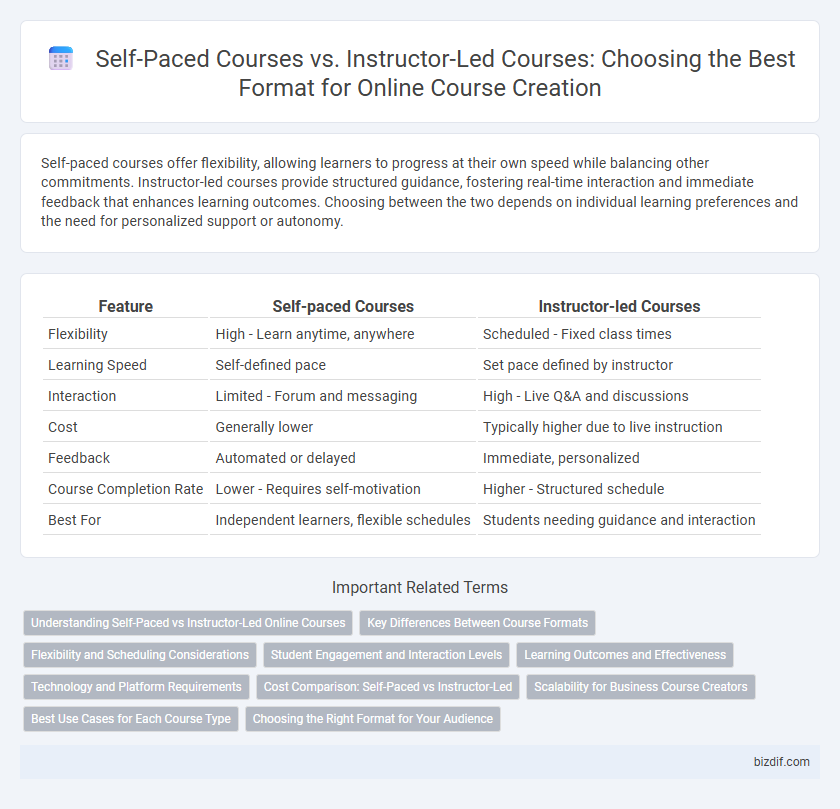Self-paced courses offer flexibility, allowing learners to progress at their own speed while balancing other commitments. Instructor-led courses provide structured guidance, fostering real-time interaction and immediate feedback that enhances learning outcomes. Choosing between the two depends on individual learning preferences and the need for personalized support or autonomy.
Table of Comparison
| Feature | Self-paced Courses | Instructor-led Courses |
|---|---|---|
| Flexibility | High - Learn anytime, anywhere | Scheduled - Fixed class times |
| Learning Speed | Self-defined pace | Set pace defined by instructor |
| Interaction | Limited - Forum and messaging | High - Live Q&A and discussions |
| Cost | Generally lower | Typically higher due to live instruction |
| Feedback | Automated or delayed | Immediate, personalized |
| Course Completion Rate | Lower - Requires self-motivation | Higher - Structured schedule |
| Best For | Independent learners, flexible schedules | Students needing guidance and interaction |
Understanding Self-Paced vs Instructor-Led Online Courses
Self-paced courses offer flexibility by allowing learners to access materials anytime, accommodating individual learning speeds and schedules, which enhances personalized engagement. Instructor-led courses provide structured guidance, real-time interaction, and immediate feedback from educators, fostering a collaborative learning environment. Understanding these differences is crucial for selecting the optimal online course format that aligns with learners' needs and educational goals.
Key Differences Between Course Formats
Self-paced courses offer learners flexibility to access materials anytime, allowing individualized pacing and repeated review, while instructor-led courses provide real-time interaction and structured schedules that enhance accountability and immediate feedback. Self-paced formats use pre-recorded videos, quizzes, and discussion boards, contrasting with live lectures, group activities, and synchronous assessments in instructor-led settings. Understanding these differences helps educators tailor course design to learner needs, engagement levels, and instructional goals.
Flexibility and Scheduling Considerations
Self-paced courses offer unmatched flexibility, allowing learners to access content on their own schedule and progress at a personalized pace, ideal for busy professionals. Instructor-led courses require fixed schedules, providing structured timelines and real-time interaction, which benefits those needing guided support and immediate feedback. Choosing between these formats depends heavily on individual time availability and learning preferences, with self-paced suited for autonomous learners and instructor-led for those valuing direct instructor engagement.
Student Engagement and Interaction Levels
Self-paced courses offer flexible learning schedules but often lack real-time interaction, which can lead to lower student engagement and reduced opportunities for immediate feedback. Instructor-led courses foster higher levels of student engagement through live discussions, collaborative activities, and direct interaction with instructors, enhancing motivation and comprehension. Integrating interactive elements such as quizzes and forums in self-paced courses can help bridge the engagement gap between the two formats.
Learning Outcomes and Effectiveness
Self-paced courses provide learners with flexibility to absorb material at their own speed, often enhancing knowledge retention and catering to diverse learning styles. Instructor-led courses deliver structured guidance and real-time feedback, which can improve comprehension and engagement, particularly for complex subjects. Studies indicate instructor-led formats typically yield higher completion rates, while self-paced courses excel in learner autonomy and accessibility.
Technology and Platform Requirements
Self-paced courses demand robust, user-friendly platforms that support asynchronous learning features like video streaming, quizzes, and progress tracking, ensuring flexibility for learners. Instructor-led courses require technology that enables live interaction, such as video conferencing tools, real-time chat, and scheduling systems, to facilitate direct communication between instructors and students. Platforms must provide scalable infrastructure and integration capabilities to accommodate both formats effectively, optimizing the learning experience across diverse devices and connection speeds.
Cost Comparison: Self-Paced vs Instructor-Led
Self-paced courses generally have lower production and delivery costs due to pre-recorded materials and the absence of live instructors, making them more affordable for both providers and learners. Instructor-led courses involve higher expenses, including instructor salaries, scheduling coordination, and real-time interaction platforms, which increase overall investment. Organizations aiming for scalability and cost-efficiency often prefer self-paced formats, while those prioritizing personalized guidance may justify the higher cost of instructor-led sessions.
Scalability for Business Course Creators
Self-paced courses offer unparalleled scalability for business course creators by allowing unlimited enrollment without additional instructor resources, enabling exponential revenue growth. Instructor-led courses require managing schedules and personalized engagement, limiting the number of participants and increasing operational costs. Leveraging self-paced formats maximizes content reuse and audience reach, essential for scaling online education businesses efficiently.
Best Use Cases for Each Course Type
Self-paced courses excel in delivering flexible, personalized learning experiences ideal for working professionals and lifelong learners balancing busy schedules. Instructor-led courses provide real-time interaction and immediate feedback, making them best suited for complex subjects requiring guided support or collaborative group activities. Choosing the right course type depends on learner needs, content complexity, and desired engagement levels.
Choosing the Right Format for Your Audience
Self-paced courses offer learners flexibility to progress at their own convenience, ideal for busy professionals and independent learners seeking control over their schedule. Instructor-led courses provide real-time interaction and structured guidance, benefiting students who thrive on direct engagement and immediate feedback. Understanding your audience's learning preferences and availability is crucial in selecting the optimal format that maximizes engagement and knowledge retention.
Self-paced courses vs Instructor-led courses Infographic

 bizdif.com
bizdif.com